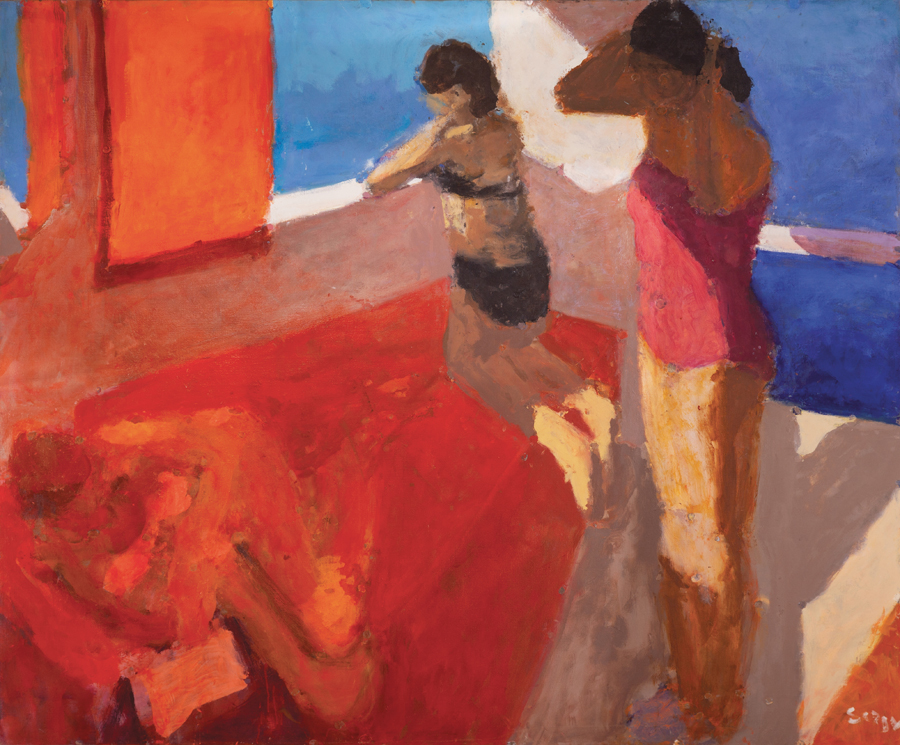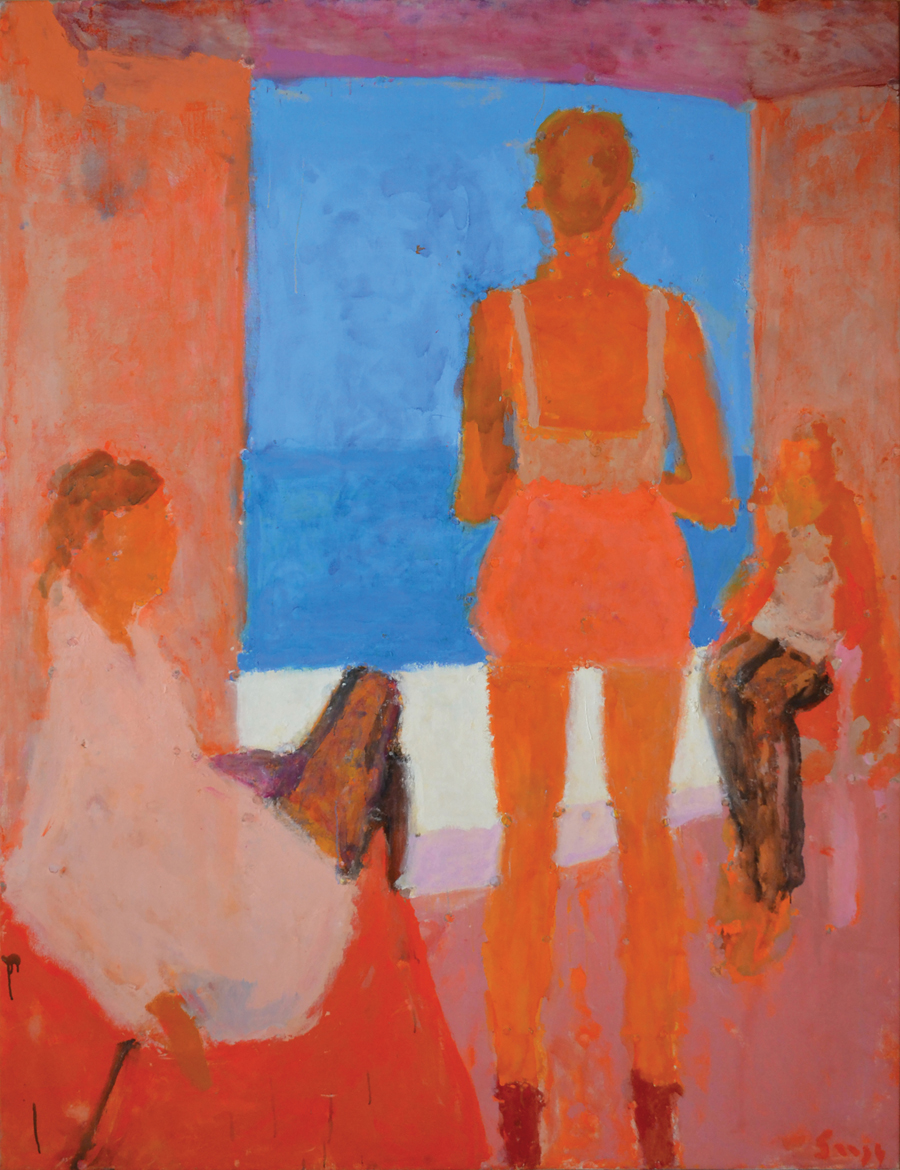Seeing the Light in Sargy Mann’s ‘Little Sitting Room’ Paintings
A new exhibition in London shows the late painter as a master of colour – even after losing his eyesight
A new exhibition in London shows the late painter as a master of colour – even after losing his eyesight

I like this room. It’s on the edge of things, not quite open, not quite closed, a little lightbox high above the sea. People, maybe the same four, five, six people, gather there in bathing suits, slouching on the mint / buttercup / tangerine-coloured couch, wrapped in a white towel or fiddling with their hair. A girl in a black bikini kneels at the window, elbows on the sill. The sun licks her ankles, casts a rose-pink wash, bowls long shadow legs right through the picture plane.
The room has an unusual geometry, what the late British painter Sargy Mann, talking into his tape recorder, might have described as ‘very exciting’. It’s up a flight of steps. There is no door, only an open balustrade. Sometimes a figure approaches, often a man in a white shirt and hat. All of these paintings draw at the well of Henri Matisse; they could be titled Luxe, Calme et Volupté, and not just for the repeating architecture of infinity pools, the expensive chlorine rectangle lapped by a receding bar of ultramarine. They are testimonials to the abundant pleasures of light and space, the idle hour between swim and beer when everyone drifts into the same small room to pass the time together.
Mann began what he sometimes called the ‘Little Sitting Room’ or ‘Infinity Pool’ paintings in 2010 and worked on them for the last five years of his life. He’d gone completely blind five years before, when a detached retina in his left eye put paid to the final vestiges of his vision. His sight, never good, had diminished incrementally over decades, starting in 1972 with the diagnosis of cataracts. Though it should be catastrophic for a painter, there were compensations to diminished vision. For a start, he had to look far harder than most people, to puzzle out all the components of a scene – depth, colour, geometry, light – rather than relying on the misleading instantaneity of so-called perfect sight, the simplifications and frank corruptions the brain makes out of constantly seething visual data.

In her 1974 essay ‘Seeing’, Annie Dillard writes covetously about the experiences of a group of people, blind from birth, who recovered their sight after cataract operations in the 19th century. Their brains had never learned how to make sense of visual information and so, for a time, they saw the world unprocessed and unsorted: a flat, depthless dazzle of colour patches, some bright and some so black they looked like holes. Trees glowed like flames; each visitor had a madly unique face. If only someone had given them brushes, Dillard writes, ‘then maybe we all could see colour-patches too, the world unravelled from reason’.
Like Claude Monet, one of his favourite painters, Mann had yellow-brown cataracts, which meant that after they were removed his brain continued to compensate for the diminishment of cool colours. For weeks, blues, greens, violets and magentas were almost painfully magnificent, an ‘Aladdin’s cave’ of heightened visual intensity that filled his landscapes of the period with chinks and streamers of near-Fauvist colour. Years later, in India, everything abruptly turned a wonderful apricot; palm trees marmalade, the sea fig-pink.
Sometimes Mann saw spectral haloes; when his sight was very poor, he assembled a view piecemeal by gazing at it through a miniature telescope given to him by Moorfield’s Eye Hospital. Audio diaries and collages of enlarged photographs took the place of sketchbooks. Suffering from oedema of the cornea, he took a hair dryer to the National Gallery, plugged it in and calmly dried his soggy, waterlogged eye in order to see the paintings. There was always a way of adjusting, capitalising on as well as compensating for the shift.

All the same, total blindness might have marked the end of his time as a painter (he glumly contemplated sculpture), if it hadn’t been that his head was already full of pictures. Two day before the detached retina, he’d come back from a trip to Cadaques, a fishing village in northern Spain, where he’d been casting around for new subjects with the help of his son Peter. In the audio diaries he made there, you can hear his combined excitement and bafflement as, tapping up and down steps with his white stick, he’d discovered exactly the kind of complex, dazzlingly coloured view he loved to paint.
Pottering about in the now-permanent darkness of his studio, he remembered the presence of a stretched canvas. Might as well give it a shot. His palette was always laid out in the same configuration. He rarely mixed colours in advance, but scumbled, glazed or layered directly on the canvas. To his surprise, it wasn’t as hard as he’d expected. He could play blindfold chess and this was a not dissimilar process. What mattered was constructing and adjusting the image in his mind, measuring and remeasuring with his stick, making a kind of haptic map or under-drawing with lumps of Blu Tack before laying on the zones of colour. ‘It was difficult alright,’ he said, ‘but it had always been difficult.’
The Cadaques paintings came fast, culminating in 2006 in Black Windows, with its strange, divergent, guileful perspective. The sombre figure looking through light into blackness could be read metaphorically, were it not for the abundant distractions along the way, the lush, almost abstract slabs of Schmincke magenta, emerald green and yellow ochre. ‘Still,’ as Vincent Van Gogh wrote to his brother Theo in 1882, ‘a great deal of light falls on everything.’
Before Mann went to art school he trained as an engineer. It was those skills he drew on now, as well as the deep reservoir of a life’s accumulated close seeing. He was trying to do what he had always done: figure out how to resolve three dimensions in two; represent curved space on flat; shrink without distorting; get a sense of believable space that wasn’t illustrative but rather captured what being in a particular place had actually felt like. Like Pierre Bonnard, he rarely painted in front of the actual scene. Doing it in the dark was a challenge, but not – measuring stick in hand – an impossibility.
After the Cadaques paintings were finished, the difficulty was what to turn to next, since no new landscapes in Portugal or Italy would be discoverable. For a while he painted his wife Frances sitting in a chair, a set-up apprehended entirely by way of touch. It was while he was working on these paintings that he realised he was no longer tethered by the reality of colour. ‘You silly bugger,’ he said to himself when he got up to cover the ugly brown chair with a white dust sheet, ‘you won’t be able to see it. You can make the chair any colour you like.’ If he couldn’t see colour, he was no longer under an obligation to record it accurately but could instead assemble colour chords that were purely decorative. At last, his paintings could be as saturated as he liked.

The problem of a subject lingered. Back in 2001, he’d designed a sitting room at the top of the stairs in his Suffolk house, with a glass wall on one side. He’d always found it a fascinating space to paint. The light fell from multiple angles and the stairwell formed a curious black hole. On 4 September 2008, he came in from his studio to get a jersey. Lingering on the stairs, he was astonished to realise that the configuration of balustrade and steps was very close to that of Bonnard’s terrace at his home Ma Roulotte.
Mann was passionately interested in Bonnard. He went to the 1966 retrospective at the Royal Academy 24 times and in 1994 co-curated ‘Bonnard at Le Bosquet’ at the Hayward Gallery. Still standing on the stairs of his house, he began to talk animatedly into his tape recorder, walking himself inch by inch towards an entirely new approach. ‘Imagined painting. Felt myself moving in that familiar, exciting space of the stairwell. Perhaps having the sea through the windows. Space and architecture out there is very reminiscent. Absolutely no reason why not. A whole wallop of sea. Very exciting.’
For a start, his sitting room had the virtue of being small. He could populate it with real, known people: his wife, his sons and daughters, standing or sitting at the necessary finger-tip reach by which he was confined. The walls, the steps: all this was accurately mappable. He could be, as he put it, ‘answerable’ to it. But what happened outside could be assembled more freely. As with colour, so with landscape: what he could no longer perceive he was legitimately free to invent.
As a little boy in the 1940s Sargy loved making camps and dens. The pleasure of building spaces from which you could see and not be seen became more acute after his father, with whom he did not get on, returned from the war. Something of this childish glee animates the ‘Little Sitting Room’ paintings: the sense of being in a safe place, at once contained and open, with multiple escape routes. Louise Bourgeois, by no means an influence on Mann, attested to a similar kind of pleasure in containment in her sculptural installations ‘Cells’, describing them as ‘a place to go, a place you need to go, a transitory protection’.
In a funny way, Mann’s blindness set him free. Taught by Frank Auerbach and Euan Uglow in the early 1960s, he came up under the influence of the School of London, but his heart was in France and particularly with Monet and Bonnard. It wasn’t just about their free, intuitive use of colour, but also the radical treatment of space, in particular Bonnard’s wide angles, his constant nudging of how much you could cram inside the frame. (A field of view of 60 degrees was common; Mann found two paintings that spanned an ‘incredible’ 130 degrees.) Mann, too, was always expanding the field of vision, greedy to capture the periphery of the gaze.

He’d always shied from the figure, preferring unpopulated or at best distantly or vaguely peopled landscapes. Now, he was brought forcibly to the human body. After his blindness, figures had to be touchable, which meant they loomed large in the frame, especially considering the enormous heft of his canvases. Like Bonnard’s wife, towelling herself three or four feet away from her husband, their closeness presented appealing problems of perspective, not least the ongoing desire to avoid foreshortening, to maintain true anatomical proportions.
Like Bonnard’s wife, the closeness of bodies in Mann’s late paintings also carries an emotional charge for the viewer, since we do not normally come so near to people, especially when they’re practically naked, unless we are intimate with them. At the same time, a possible overspill of tenderness is resisted by the featurelessness of the figures, their blocky, bulky quality, as well as the strangeness of the perspective and the rigorous geometric accounting. It’s this weird warmth/coolness as much as the stupendous palette, the deft unseeing strokes of a master colourist, that accounts for the depth charge of these paintings. Nothing much is happening, but everyone that matters is in the room.
‘Sargy Mann: Late Paintings’ is on at Royal Drawing School, London from 27 February – 10 March






















